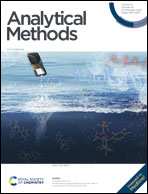Development of fluorescence sensors with copper-based nanoclusters via Förster resonance energy transfer and the quenching effect for vanillin detection†
Abstract
Two kinds of copper-based metal fluorescent nanoclusters were successfully prepared by the chemical reduction method; one of them (CuNCs) was synthesized by direct reduction of copper sulfate, and the other (CuAuNCs) was synthesized by the stepwise addition of copper salt and chloroauric acid. CuNCs were used to establish the fluorescence resonance energy transfer (FRET) system with neutral red (NR) due to the supramolecular effect of β-cyclodextrin (β-CD) modified on the surface of CuNCs. NR could enter the hydrophobic cavity of β-CD and narrow the distance between CuNCs and NR, which could lead to FRET. Fluorescence was transferred from CuNCs to NR, resulting in amplification of the NR fluorescence signal, which could be used to detect vanillin. In addition, CuAuNCs with strong fluorescence were used as fluorescent probes to detect vanillin through the quenching mechanism. By comparison, the simplicity of CuNC synthesis and the high selectivity of β-CD made the FRET method more practical, which may provide a new strategy for assaying vanillin.



 Please wait while we load your content...
Please wait while we load your content...